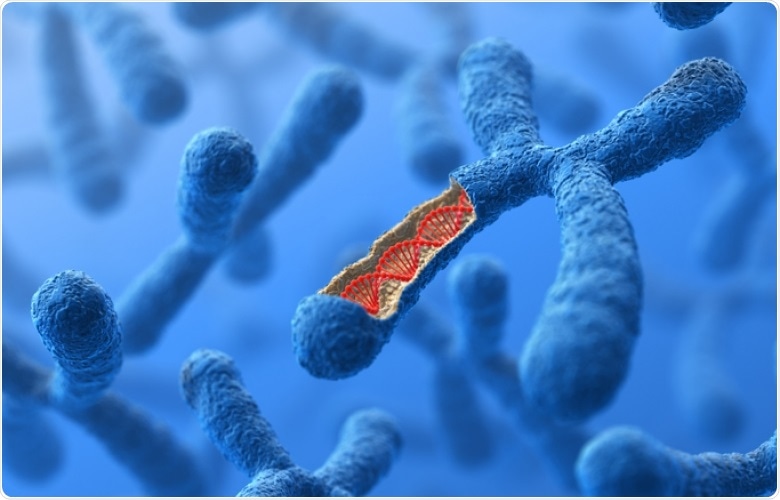A novel sequencing technique developed by Karolinska Institute researchers helps to map the spatial arrangement of DNA in the cell nucleus, revealing which regions of the genome are at greater risk of mutation and DNA damage.
The new approach has been explained in an article published in Nature Biotechnology, a scientific journal.

The spatial arrangement of individual genes in the cell nucleus has remained largely unexplored. Image Credit: Getty Images.
A majority of the cells found in the human body are made of nearly 2 m of DNA. This extensive stretch of DNA is divided into 46 massive pieces called the chromosomes. Chromosomes occupy distinct areas of the cell nucleus called chromosome territories.
The spatial arrangement of individual parts of the genome in the nucleus strongly impacts the way they are being read by the transcriptional apparatus of the cell. But this spatial arrangement of individual genes in the three-dimensional (3D) space of the nucleus is yet to be thoroughly explored.
High-resolution maps
Now, a research team, headed by Dr. Magda Bienko at Science for Life Laboratory (SciLifeLab) and the Department of Medical Biochemistry and Biophysics at Karolinska Institute, has devised a new genomic technique called Genomic loci Positioning by Sequencing, or GPSeq for short.
This technique can be used to acquire high-resolution maps of the spatial arrangement of DNA in the cell nucleus.
The GPSeq technique works by slowly splicing the DNA from the nuclear periphery toward the core, followed by reading the sequence of the DNA around each cut.
Mathematical modeling can be subsequently employed to reconstruct the structure of the 3D genome and locate where individual genes and regions between genes are situated along the nuclear radius and also with respect to one another.
We found that the spatial distribution of different types of chromatin (composed of DNA, RNA and protein complexes) often differed from what we expected to find. To our surprise, we found that the picture is not as simple as having all the inactive chromatin sitting at the nuclear periphery and the active chromatin amassed in the center.”
Magda Bienko, Study Co-Senior Author, Science for Life Laboratory and Department of Medical Biochemistry and Biophysics, Karolinska Institute
Bienko continued, “Instead, there is a continuum, a gradient of increasing activity from the nuclear periphery towards the interior, even though the inactive chromatin can be found in the very center of the nucleus too.”
Revealing which regions are at risk
According to Crosetto, a significant aspect of knowing where different regions of the genome are located in the nucleus is that one can map the areas where damage and mutations of the DNA are most likely to take place.
We discovered that DNA mutations that are often encountered in different cancer types are enriched in the inactive chromatin located at the nuclear periphery, which might have to do with the fact that many mutagens originate from outside the cell.”
Nicola Crosetto, Study Co-Senior Author and Senior Researcher, Department of Medical Biochemistry and Biophysics, Karolinska Institute
“On the other hand, DNA breaks and gene fusions are much more likely to be found in the nuclear center, which might be due to the high levels of transcription that we find in the center,” Crosetto concluded.
Source:
Journal reference:
Girelli, G., et al. (2020) GPSeq reveals the radial organization of chromatin in the cell nucleus. Nature Biotechnology. doi.org/10.1038/s41587-020-0519-y.